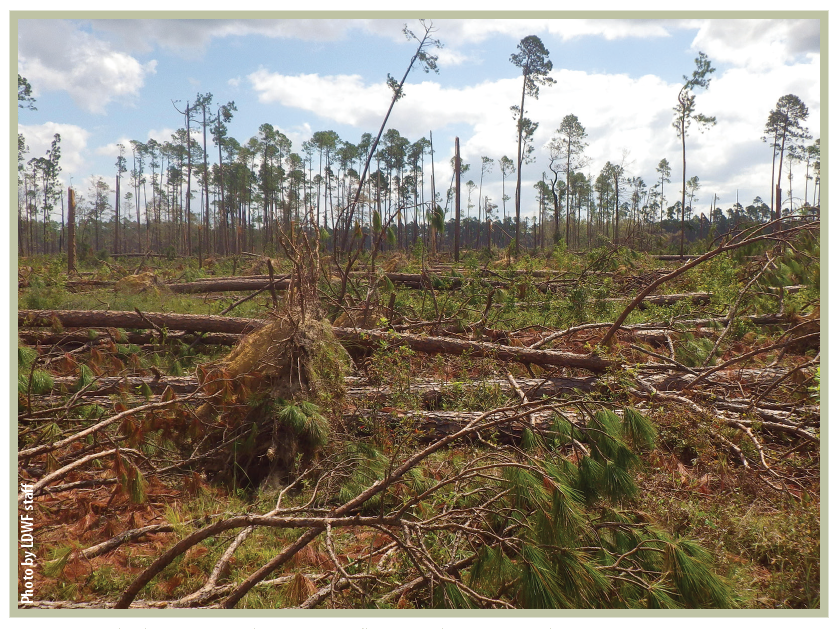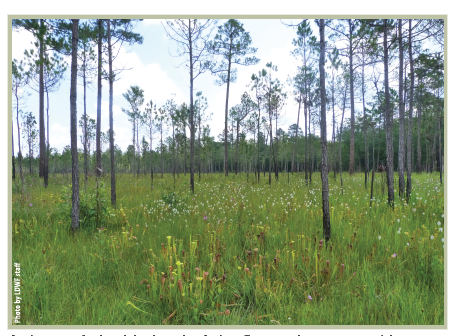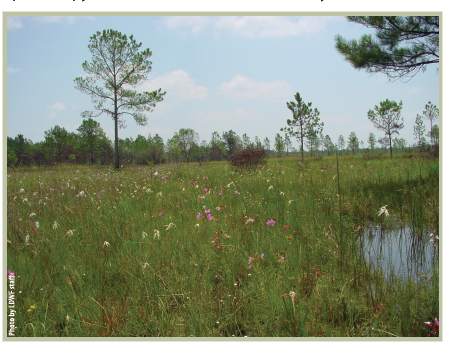| The greatest concentrations of rare plants in Louisiana are in longleaf pine habitats of St. Tammany and Vernon parishes. The inset shows the Longleaf Pine Flatwoods Savanna Restoration Project site. |
Like rare plants, the greatest concentrations of rare natural communities occur in the longleaf pine regions of the state. The inset shows the Longleaf Pine Flatwoods Savanna Restoration Project site. |

USFS and LDWF Longleaf Pine Flatwoods Savanna Restoration
Longleaf pine flatwoods savannas are ancient landscapes that have been formed over millennia by many very complex interactions between fire, water, wind, and wildlife. These longleaf pine systems occur on the outer coastal plains of the southeastern United States (see range map below). Longleaf pine flatwoods savannas are distinguished by sparsely stocked longleaf pine (Pinus palustris) stands with an open canopy, minimal topography, and highly diverse groundcover. These savannas typically occur on acidic, sandy to sandy loam soils. Longleaf pine systems are fire climax habitats, meaning without frequent fire, they collapse.
Historically, lightning strikes ignited natural fires which shaped the biota, structure, and distribution of longleaf pine communities. These lightning strikes occurred throughout the year, but were most frequent during the early growing season (April-June) and typically occurred once every one to three years on average. Many of the savannas in the surrounding areas are fire-suppressed which has led to minimal groundcover and dense brush encroachment.


Conservation and Restoration
The Kisatchie National Forest, in collaboration with the Louisiana Department of Wildlife and Fisheries, has initiated the Longleaf Pine Flatwoods Savanna Restoration Project. The flatwoods savanna project area has been set aside for intensive ecological restoration and research due to its high biodiversity and distinct geology as well as the extensive damage it sustained from past human activities and recent severe wind events.
This project encompasses approximately 7,324 acres on the southern end of the Vernon Unit of Kisatchie National Forest. Prior to U.S. Forest Service ownership, this site was clear-cut for timber production in the 1930s. With a timber production focus, the Civilian Conservation Corps converted open longleaf pine flatwoods savannas to dense forests of slash pine (Pinus elliottii), which is not native west of the Mississippi River.
The Forest Service has reintroduced fire to the landscape, opened up some of the dense slash pine stands to restore a savanna habitat, and begun replacing slash pine with native longleaf pine.
Kisatchie National Forest has set a noble mission to restore the longleaf pine flatwoods savannas present within the forest. This restoration site not only represents the only longleaf pine flatwoods savanna on the Kisatchie National Forest, but also the largest tract of this habitat type under conservation management within the state of Louisiana.
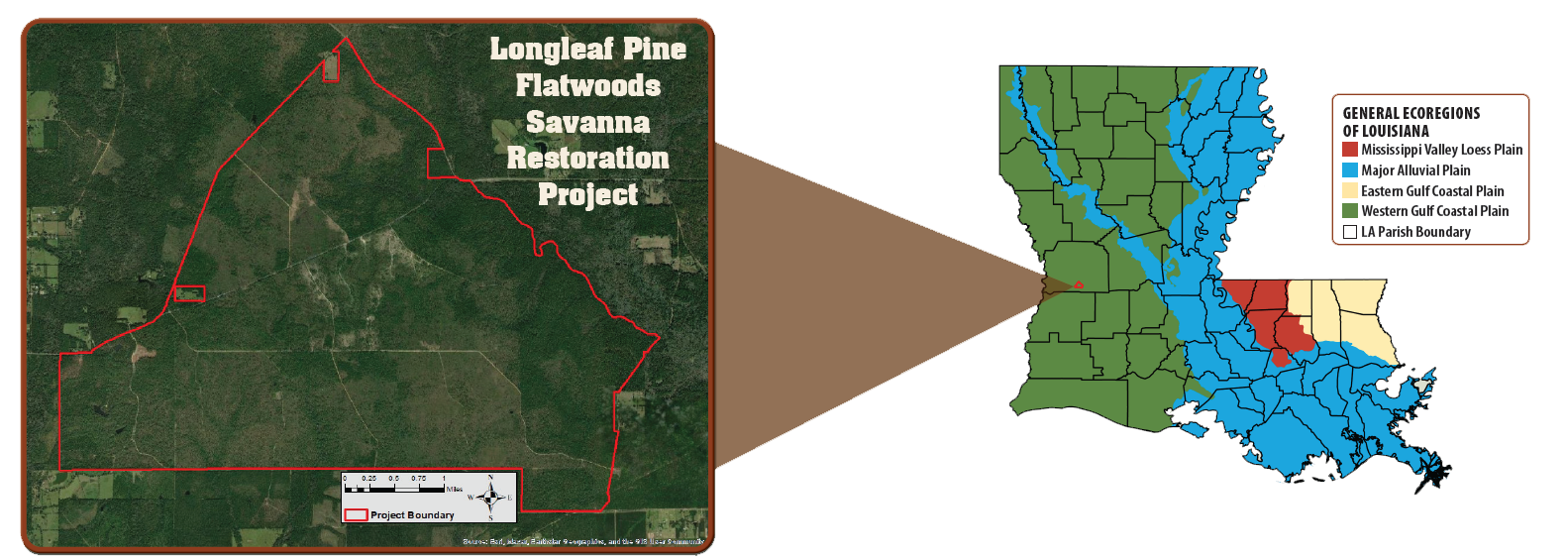
Flatwoods Savanna LandscapeRestoration Site
This project site is an ecotone (the edge or transition zone between two habitats or regions), including longleaf pine flatwoods savannas and longleaf pine rolling slope savannas and woodlands. Topographic change in longleaf pine flatwoods savannas of the Western Gulf Coastal Plain are subtle but profound, as they drastically change the vegetative communities.
The high species diversity and richness of this site is in part due to the unique and complex topography. Characteristic features of this community type include slight rises in elevation in the shape of small circles or ovals called pimple mounds, depressions called ponds, and wet to dry flats. These ancient landscape features formed during an arid period when vegetation was sparse and winds shifted sediment across the landscape. These winds scoured out depressions and redeposited sediment at the base of remaining sparse clumps of vegetation, forming ponds and pimple mounds.
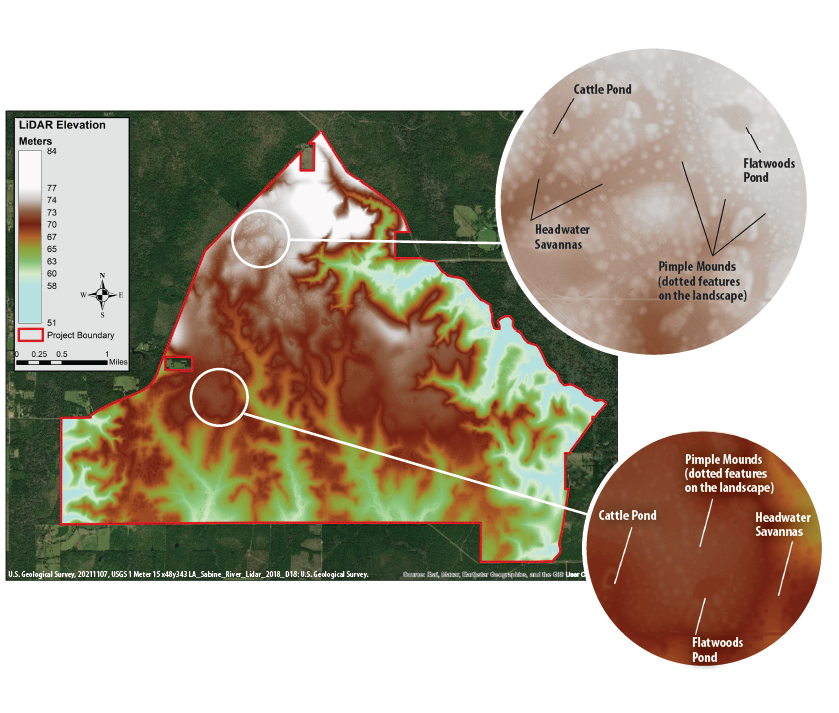
Pimple mounds are generally 1.5 to 6 feet high and 30 to 90 feet in diameter. The ponds range from 0.1 to 20 acres but typically are 1-5 acres. They vary from several inches to about 3-5 feet deep and fluctuate between seasonal to nearly year-round inundation.
These features provide drastically different microhabitats within feet of each other. The mounds have dry upland conditions; the depressions provide aquatic to wetland conditions; while the flats and headwaters between these features provide transitional zones.
This restoration site captures all the unique expressions of longleaf pine flatwoods savannas including flatwoods ponds, pimple mounds, flats, headwater savannas, and hillside seepage bogs.
Historically numbering in the millions, the pimple mounds covered large sections of western Louisiana and East Texas. Site preparations and leveling for agriculture, pine plantations, and urban development have erased a staggering proportion of these unique features from the landscape.
Diversity
Longleaf pine natural communities are among the most threatened ecosystems in the United States.
Restoration of this ecosystem is increasingly important to avoid continued decline or complete loss of the ecosystem and the benefits it provides.

Longleaf pine natural communities have particularly high rates of species endemism (an indigenous species that is naturally limited to a small geographic range). These communities comprise one of the most species rich sets of plant assemblages outside the tropics.
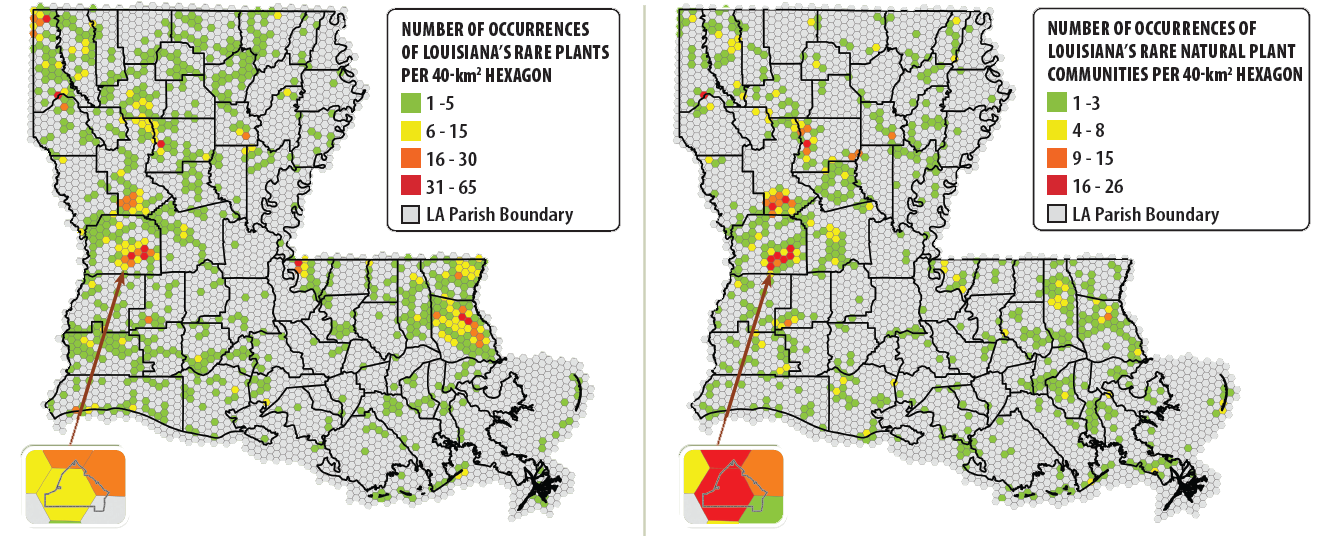
Hurricanes and Recent Wind Events
The longleaf pine systems in Louisiana sustained great impacts during the 2020 hurricane season, which caused over $63 million in losses on the Kisatchie National Forest. Approximately 200,000 acres on Kisatchie National Forest received wind damage.
The longleaf pine flatwoods savannas and upland savannas on the southern portion of the Vernon Unit received the most extensive and severe wind damage (over 20,000 acres damaged). Varied use of heavy machinery for debris removal was employed to test the effects on the recovery time of longleaf pine systems. These sites will be monitored for long-term research and the data will be used to identify best management practices for future storm clean-up operations in sensitive habitats.
